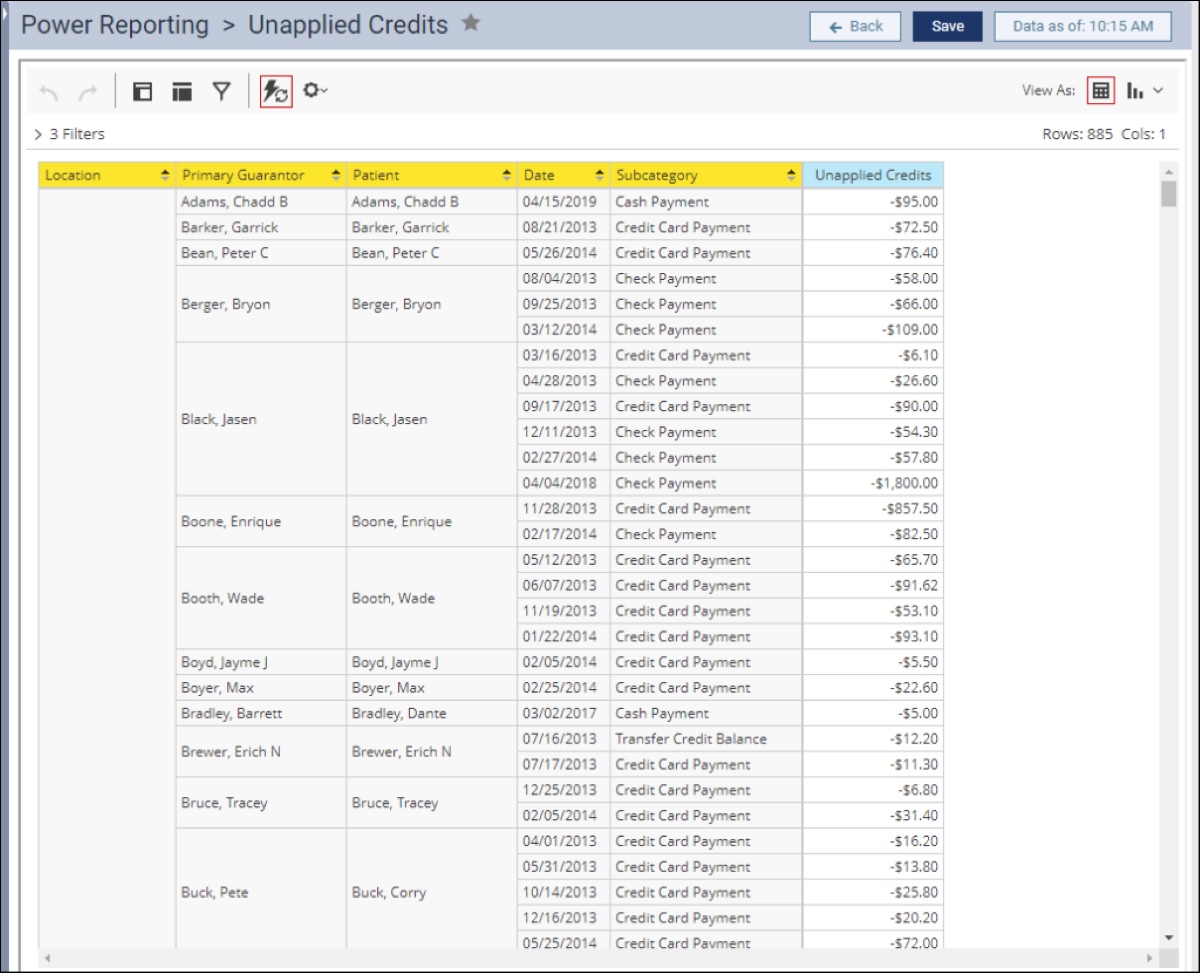

Finance
What Is A Rent Credit
Modified: February 21, 2024
Discover the ins and outs of rent credits and how they can help you financially. Find out everything you need to know about rent credits in the world of finance.
(Many of the links in this article redirect to a specific reviewed product. Your purchase of these products through affiliate links helps to generate commission for LiveWell, at no extra cost. Learn more)
Table of Contents
Introduction
Welcome to the world of rent credit! If you’ve ever rented a property or are considering doing so, understanding the concept of rent credit can be beneficial. Rent credit is a term that is often used in the real estate and rental industry, but many people are not familiar with its meaning or purpose. In this article, we will explore what rent credit is, how it works, and the advantages and disadvantages it offers.
When renting a property, most individuals are familiar with the concept of paying rent each month to their landlord or property management company. However, rent credit takes this traditional rental arrangement a step further by offering tenants the opportunity to earn credits towards their rent payments.
Rent credit is essentially a financial arrangement that allows tenants to accumulate credits that can be deducted from their monthly rent payments. This means that instead of solely making cash payments for rent, tenants can have a portion of their rent covered by the accumulated credit.
The idea behind rent credit is to incentivize and reward tenants for various factors, such as on-time payments, long-term lease agreements, or improvements made to the property. It provides an opportunity for tenants to save money on their monthly rent payments while simultaneously encouraging responsible tenancy and fostering positive landlord-tenant relationships.
While rent credit may not be commonly offered in every rental situation, it is increasingly being utilized by landlords and property owners as a way to attract and retain reliable tenants. It can be particularly advantageous for individuals who are looking for ways to reduce their monthly living expenses or who value stability and long-term commitments.
In the following sections, we will delve deeper into the specifics of rent credit, including how it works, the benefits it offers, the potential drawbacks to consider, tips for negotiating rent credit agreements, and some real-life examples to provide a better understanding of its application in the rental market.
Definition of Rent Credit
Rent credit is a term used in the real estate and rental industry to describe a financial arrangement where tenants are able to accumulate credits that can be applied towards their monthly rent payments. It is a form of rent concession provided by landlords or property owners to incentivize and reward tenants for certain actions or behaviors. These actions typically include making on-time rent payments, signing a long-term lease agreement, or making improvements to the property.
When a tenant earns rent credit, it functions as a discount on their monthly rent payment. For example, if a tenant has accumulated $100 in rent credit and their monthly rent is $1,000, they would only need to pay $900 out of pocket for that month’s rent. The remaining $100 would be covered by the accumulated rent credit.
Rent credit can be a valuable benefit for tenants as it allows them to reduce their overall housing expenses. It provides an opportunity to save money and potentially allocate those savings towards other financial goals or expenses. Additionally, rent credit can promote a sense of stability and encourage long-term tenant-landlord relationships.
It’s important to note that rent credit is different from a security deposit. A security deposit is a refundable amount of money that tenants provide to landlords as a form of protection against potential damage or unpaid rent. Rent credit, on the other hand, is a non-refundable credit that can be deducted from monthly rent payments.
Rent credit arrangements can vary depending on the specific terms and conditions set by the landlord or property owner. The amount of rent credit earned, the duration it can be applied for, and the actions required to earn the credit will all be outlined in the rental agreement or lease contract.
In the next section, we will explore how rent credit works and the mechanics behind this financial arrangement.
How Rent Credit Works
Rent credit works by providing tenants with the opportunity to accumulate credits that can be applied towards their monthly rent payments. The mechanics behind rent credit can vary depending on the specific terms and conditions set by the landlord or property owner. Here are the key components to understand how rent credit works:
Accumulating Rent Credit: Tenants can accumulate rent credit by fulfilling certain conditions or meeting specific criteria outlined in the rental agreement or lease contract. These conditions may include making on-time rent payments, signing a long-term lease agreement, or making improvements to the property approved by the landlord. The amount of rent credit earned will typically be specified in the rental agreement.
Applying Rent Credit: Once tenants have accumulated rent credit, they can apply it towards their monthly rent payments. The credit serves as a discount, reducing the amount of cash they need to pay out of pocket. This means that if a tenant has accumulated $200 in rent credit and their monthly rent is $1,000, they would only need to pay $800 for that month’s rent.
Expiration of Rent Credit: Rent credit may have an expiration date or a specific time frame during which it can be applied. It is important for tenants to be aware of any expiration dates to ensure they utilize their rent credit within the designated period. Landlords may set expiration dates to encourage consistent tenancy or prevent the accumulation of excessive rent credit.
Non-Refundable Credit: Rent credit is typically a non-refundable credit, meaning it cannot be redeemed for cash or transferred to another tenant. It is solely intended to be applied towards monthly rent payments.
Maximum Applied Credit: Some rental agreements or lease contracts may set a maximum limit on the amount of rent credit that can be applied each month. For example, if a tenant has accumulated $500 in rent credit but there is a maximum monthly limit of $200, they can only apply $200 towards their monthly rent even though they have a higher balance of rent credit.
Overall, rent credit provides tenants with the opportunity to reduce their monthly rent expenses by accumulating credits that can be applied towards their rent payments. It is essential for tenants to understand the specific terms and conditions related to rent credit outlined in their rental agreement to maximize its benefits.
In the next section, we will explore the benefits that rent credit offers to tenants.
Benefits of Rent Credit
Rent credit offers several benefits to tenants, making it an attractive option for those seeking to reduce their monthly rent expenses and enjoy additional advantages. Here are some of the key benefits of rent credit:
1. Financial Savings: The most obvious benefit of rent credit is the financial savings it provides. By accumulating rent credit, tenants can effectively reduce their monthly rent expenses. This can free up extra cash that can be used for other necessities, savings, or discretionary spending.
2. Incentive for Responsible Tenancy: Rent credit serves as an incentive for tenants to fulfill certain obligations, such as making on-time rent payments or signing a long-term lease agreement. By rewarding responsible tenancy, landlords encourage positive behavior and foster a better relationship with their tenants.
3. Stability and Long-Term Commitment: Rent credit arrangements often favor tenants who commit to longer lease terms. By offering rent credits, landlords can attract and retain tenants who are willing to stay for an extended period. This stability benefits both parties by minimizing turnover costs and ensuring consistent rental income.
4. Improvement Opportunities: Some rent credit agreements may allow tenants to earn credits by making approved improvements to the property. This gives tenants the opportunity to enhance their living space and potentially increase the value of the property while earning rent credits in the process.
5. Positive Landlord-Tenant Relationships: Rent credit can contribute to a positive landlord-tenant relationship. Tenants appreciate the opportunity to save money on rent, while landlords value responsible and long-term tenants. This mutual benefit fosters a better rapport and can lead to smoother communication and conflict resolution.
6. Enhanced Rental Applications: Rent credit can provide an advantage when applying for future rental properties. Having a strong rental history with a track record of earning rent credit can make tenants more attractive to potential landlords, increasing their chances of approval in highly competitive rental markets.
7. Personal Satisfaction: Finally, earning rent credit can provide a sense of personal satisfaction and accomplishment. Tenants feel rewarded for meeting their financial obligations and responsibilities, which can boost confidence and overall satisfaction with their rental experience.
These benefits make rent credit an appealing option for tenants looking to save money on their monthly rent payments while enjoying other advantages. However, it’s essential to consider the potential drawbacks of rent credit, which we will discuss in the next section.
Drawbacks of Rent Credit
While rent credit offers several benefits, it is important to consider the potential drawbacks that tenants should be aware of before entering into a rent credit arrangement. Here are some of the key drawbacks to consider:
1. Limited Availability: Rent credit is not commonly offered in every rental situation. It is at the discretion of the landlord or property owner to decide whether to introduce rent credit as an incentive. As a result, tenants may have limited opportunities to take advantage of this benefit.
2. Stringent Conditions: Rent credit often comes with specific conditions that tenants must meet to earn and maintain the credit. These conditions can be strict and may require meeting deadlines, fulfilling certain obligations, or making improvements that are approved by the landlord. Failure to comply with these conditions may result in the loss of rent credit.
3. Expired Credits: Rent credit may have an expiration date, meaning tenants must utilize their accumulated credits within a specified time frame. If they fail to do so, the credits may expire and become unusable. This can be challenging for tenants who are unable to fully utilize their rent credit due to unforeseen circumstances, such as job loss or the need to move out before the credits expire.
4. Non-Refundable Nature: Rent credit is typically a non-refundable credit, meaning it cannot be redeemed for cash or transferred to another tenant. This can be a disadvantage if tenants accumulate a significant amount of rent credit but are unable to fully utilize it due to rent restrictions or unforeseen changes in their living situation.
5. Rental Increase Considerations: Rent credit may not protect tenants from future rent increases. While tenants may be earning rent credit, landlords can still implement rent increases at the end of lease terms or as stipulated in the rental agreement. This means that even if tenants have accumulated rent credit, their monthly rent payment may still increase, reducing the impact of the credit.
6. Potential for Misunderstandings or Disputes: Rent credit arrangements can sometimes lead to misunderstandings or disputes between landlords and tenants. Disagreements may arise regarding the amount of credit earned, the conditions for earning it, or the application of the credit. Clear communication and a well-documented rental agreement are essential to avoid such conflicts.
Considering these drawbacks, tenants should carefully evaluate their specific situation and the terms of the rent credit arrangement before fully embracing the concept. It is crucial to weigh the potential benefits against the potential difficulties and ensure that rent credit aligns with their long-term housing goals.
In the next section, we will provide tips on how to negotiate rent credit agreements to maximize the benefits for tenants.
How to Negotiate Rent Credit
Negotiating rent credit can be a beneficial way for tenants to reduce their monthly rent expenses. Here are some tips to help tenants negotiate rent credit agreements:
1. Research the Market: Before entering into negotiations, research the rental market to understand the prevailing rental rates in the area. This knowledge will help you make an informed case for why you should be eligible for rent credit.
2. Highlight Your Qualifications: Prepare a list of qualifications that make you an ideal tenant. This can include a strong credit history, stable employment, or a track record of responsible tenancy. Emphasize why you believe you are deserving of rent credit based on these factors.
3. Offer Longer Lease Terms: Landlords often value tenants who commit to longer lease terms. Consider offering to sign a lease for an extended period, such as two years, in exchange for rent credit. This demonstrates your commitment to the property and may increase your chances of receiving rent credit.
4. Propose Improvement Projects: If the rental property could benefit from certain improvements, propose to undertake the projects at your own expense in exchange for rent credit. This can be particularly attractive to landlords who are seeking to enhance their property but may not have the time or resources to do so themselves.
5. Emphasize Reliable Payment History: Show your landlord that you have a track record of making on-time rent payments. Provide references or documentation that prove your reliability as a tenant. This can strengthen your case for rent credit as it demonstrates your commitment to meeting financial obligations.
6. Be Prepared for Negotiation: Approach the negotiation with a clear understanding of your desired outcome. Determine the maximum amount of rent credit you are seeking and be prepared to explain how you arrived at that figure. Be flexible and willing to compromise to reach a mutually beneficial agreement.
7. Get It in Writing: Once you and the landlord have reached an agreement on rent credit, make sure to have all terms and conditions documented in writing. Clarify the duration of the rent credit, any conditions or criteria to maintain it, and how it will be applied to your rent payments. Having a written agreement helps prevent misunderstandings or disputes down the line.
Remember, negotiations may not always result in a successful rent credit agreement. It ultimately depends on the landlord’s policies and willingness to offer such incentives. Nonetheless, presenting a well-reasoned case and demonstrating your value as a tenant can improve your chances of receiving rent credit.
In the next section, we will provide examples of rent credit agreements to illustrate how rent credit can work in practice.
Examples of Rent Credit Agreements
To provide a better understanding of how rent credit agreements can work in practice, let’s explore a few examples:
Example 1: On-Time Payment Incentive: In this scenario, a landlord offers a rent credit incentive to tenants who consistently make on-time rent payments. Tenants can earn a $50 credit towards their rent for each consecutive month they pay on or before the due date. This incentive encourages prompt payment and rewards responsible tenancy.
Example 2: Lease Renewal Bonus: A landlord may offer a rent credit to tenants who renew their lease for an extended term. For instance, a tenant who signs a two-year lease agreement may be eligible for a one-time $500 rent credit. This encourages tenants to commit to a longer lease term while providing them with immediate cost savings.
Example 3: Property Improvement Program: Some landlords may offer rent credit in exchange for approved property improvements made by tenants. For instance, if a tenant invests in upgrading the kitchen appliances or renovating the bathroom, they can earn a rent credit equivalent to a percentage of the total cost. This incentivizes tenants to enhance the property while reducing their monthly rent expenses.
Example 4: Stable Tenancy Discount: Another example of a rent credit agreement is a discount for tenants who maintain a stable tenancy over a specified period. For instance, after living in the property for three consecutive years, the tenant becomes eligible for a 5% rent credit each year. This encourages long-term commitments and rewards loyal tenants.
Example 5: Seasonal or Market-Based Incentive: Rent credit agreements may also include seasonal or market-based incentives. For instance, a landlord may offer a rent credit during a historically slow rental season to attract tenants. Alternatively, in a highly competitive rental market, landlords may offer rent credits to entice prospective tenants to choose their property over others.
These examples illustrate the various ways in which rent credit can be structured and implemented. It’s important to note that the specific terms, conditions, and amounts of rent credit will vary depending on the landlord’s policies and the rental market. When considering a rent credit agreement, carefully review the terms and ensure they align with your needs and objectives as a tenant.
In the next section, we will conclude our discussion on rent credit and summarize the main points covered in this article.
Conclusion
Rent credit presents an opportunity for tenants to save money on their monthly rent payments while also incentivizing responsible tenancy and fostering positive relationships between landlords and tenants. By accumulating rent credit through various actions or behaviors, tenants can enjoy financial savings and potentially enhance their overall rental experience.
In this article, we explored the definition of rent credit and how it works. We discussed the benefits of rent credit, including financial savings, stability, and the opportunity for improvement projects. We also highlighted some drawbacks to consider, such as limited availability and expiration dates on rent credit.
To negotiate rent credit agreements, tenants should research the rental market, emphasize their qualifications, and be prepared for negotiation. It’s important to have clear communication and get all agreements in writing to avoid misunderstandings or disputes.
Real-life examples of rent credit agreements illustrated how rent credit can be structured and implemented, including on-time payment incentives, lease renewal bonuses, and property improvement programs. It’s important to understand that the terms and conditions of rent credit agreements can vary depending on the landlord’s policies and the rental market dynamics.
In conclusion, rent credit offers tenants an opportunity to reduce their monthly rent expenses, incentivizes responsible tenancy, and promotes positive landlord-tenant relationships. As a tenant, understanding rent credit and the potential benefits and drawbacks can empower you to make informed decisions and negotiate agreements that align with your housing goals and financial priorities.
If rent credit is available in your rental market, consider discussing it with your prospective landlord during the lease negotiation process. By exploring the possibility of rent credit, you may be able to secure a more favorable rental arrangement and enjoy financial savings while maintaining a positive tenant-landlord relationship.














